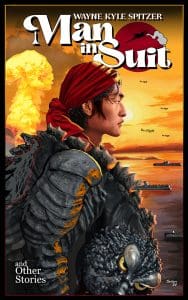About Man in Suit and Other Stories
Love Japanese giant monster movies? Ever wonder what it would be like to destroy Tokyo yourself? Or how dangerous it would be to be zipped into a 250-pound rubber suit and put into a massive tank while pyrotechnics go off and powerful lights hang above the water? Man in Suit reminds us that the people behind the monsters are all too human.
There were two things that Sakura insisted on from the start: the first was that every shooting day be concluded by crossing an enormous red number off his enormous mobile whiteboard—which he had rolled out onto the soundstage—and the second was that the Kaijira Military March, which had originally been composed for the Japanese Imperial Army during WWII, be looped and played from huge loudspeakers every time we were on set—to the point that I could hear it in my head virtually everywhere I went: in the commissary, using the restroom, on the train going home, while I was sleeping. Especially while I was sleeping.
It was, in a sense, as if we’d gone off to war—as if the blue screen material undulating before the turbines (when we shot in the outdoor tank) were in fact our banner, and Sakura’s barking of “Hajime!” our battle cry. Indeed, it was as if the sounds of our efforts—the clack-clack of the slate and the coordinated shouting of the crew, the grunting of the actors, the crackle of the pyrotechnics—had merged to become a rhythm and a cadence of their own; a mantra as guttural and precise as any karate match—a meditation. Nor was the war comparison purely hyperbolic: it’s often been said that war is not just a new experience but a new world—and this, with its bloodbath of sweat and rubber and black powder smoke, its hot lights and shockingly physical fights, was nothing if not that, at least to a kid from West Lafayette, Indiana; a kid whose previous experience with kaiju consisted mostly of watching them battle it out on a 16-inch Zenith color television whilst eating Frosted Flakes and collecting shag carpet rug burns.
And yet as the days passed and the numbers were crossed off I came to understand not just the outlandishness of what they—the suit actors—were doing but the familiarity of it; for what it ultimately boiled down to (especially with regards to what was required of them physically) was American pro wrestling—a realization that made me not just fall in love with them all over again but to really study them, to try to get inside their suits, to imagine what it was like to actually be them.
How hot it must have been, for one, how difficult to breathe. How burdensome the suit must have become after having been essentially locked inside it for several hours—the sheer weight on one’s bones and musculature, the stench of latex and one’s own body odor, the impaired hearing and vision, the claustrophobia! I couldn’t help but wonder how Sakura had managed to play the monster so late into his career—well into his 50s—nor what the old man was presently thinking now that he’d traded his fur-lined flight helmet for a bullhorn and steered toy airplanes instead of real ones.
But mostly I focused on Kikuta, who soldiered on valiantly despite the burden of two equally great weights: the Kaijira costume itself, which was the most cumbersome of them all, and Daigo’s attempt to turn a carpool with Izumi into a stealth courtship—a ploy so obvious that she herself was blind to it. Nor had a modest raise in his pay changed anything; he was still riding the same crusty moped while Daigo drove his Z and talked about upgrading, which by the second to last day of the shoot he had, to a brand-new Mazda Miata and a rear plate that read: MECHA-1.
And it might even have remained that way—at least long enough to finish the shoot—if Kikuta hadn’t opened his pay envelope as the pair drove away and realized he’d been given the wrong check …
Buy the book, and follow the author on social media:
Learn more about the writer. Visit the Author’s Website.
Author Bio:
Wayne Kyle Spitzer is an American writer, illustrator, filmmaker, and founding editor of the publications Dark Horses: The Magazine of Weird Fiction, Black Sheep: Unique Tales of Terror and Wonder, and Mobius Blvd. He is the author of countless books, stories, and other works, including Beyond the Black Curtain, X-Ray Rider and Other Dark Rites of Passage, Legends of the Flashback: The Finished Saga, The Devil Drives a ’66 and Other Stories, The Witch-Doctor Diaries and Other Dystopias, and The Place and Other Stories from the Region Between, as well as a film (Shadows in the Garden) and a screenplay (Algernon Blackwood’s The Willows). His work has appeared in MetaStellar—Speculative fiction and beyond, subTerrain Magazine: Strong Words for a Polite Nation and Columbia: The Magazine of Northwest History, among others. He holds a Master of Fine Arts degree from Eastern Washington University, a B.A. from Gonzaga University, and an A.A.S. from Spokane Falls Community College. His recent fiction includes The War-torn Hills of Earth and The Wine-Dark Passage. He shares a life with his sweetheart Ngoc Trinh Ho in Spokane Valley, Washington.
